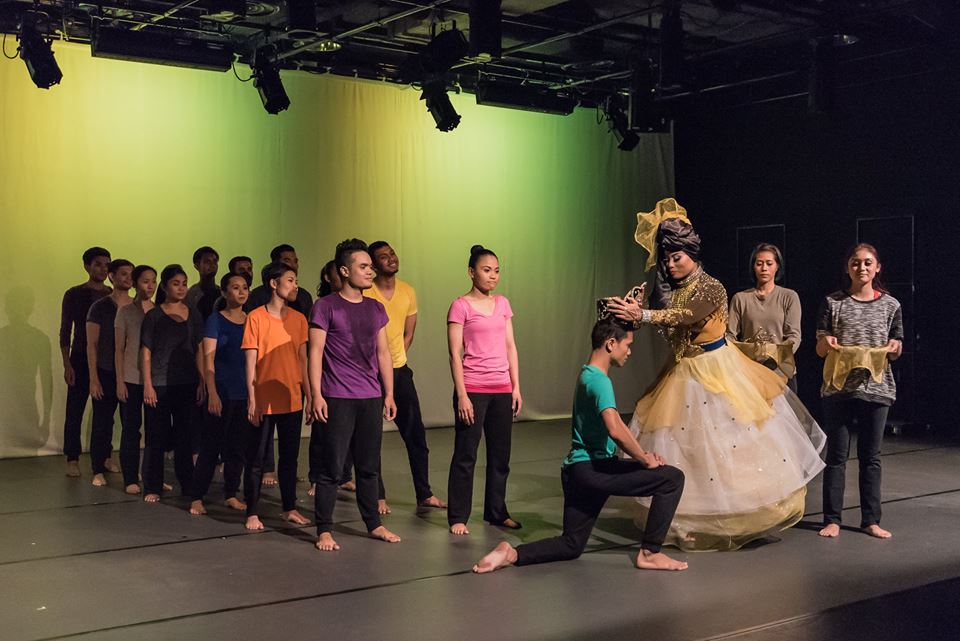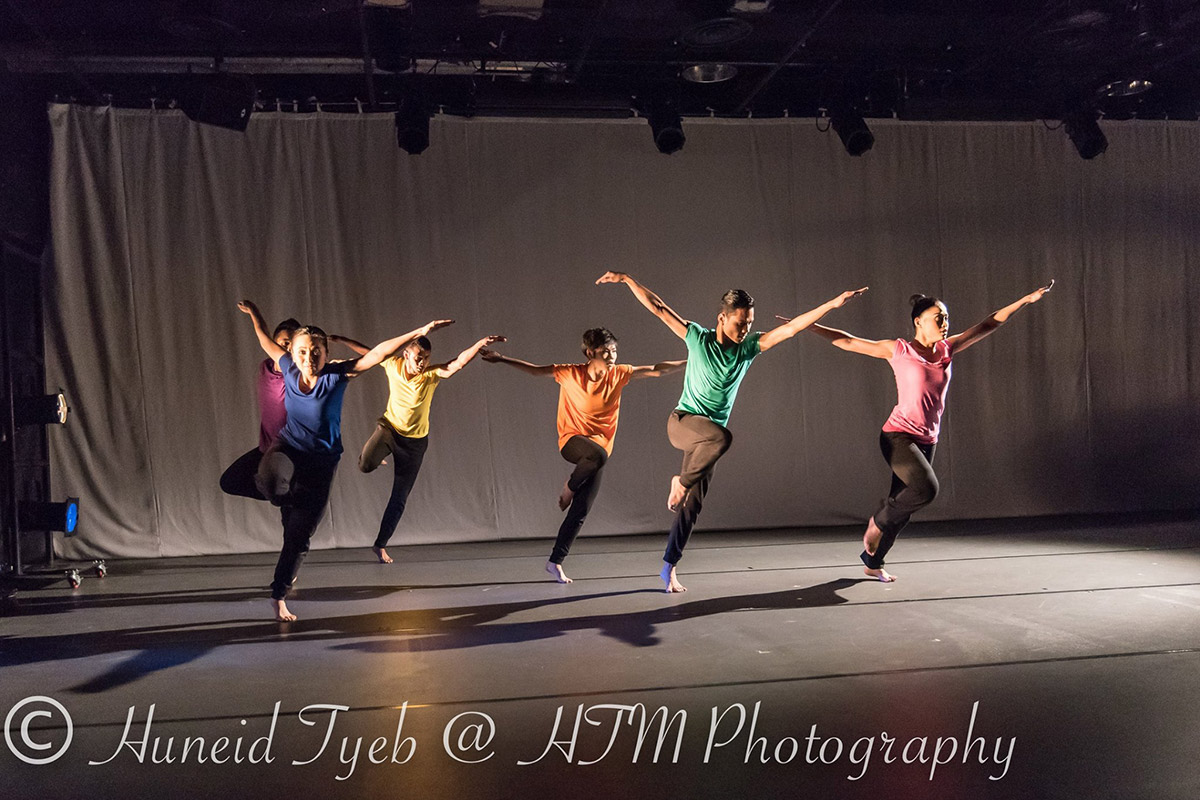National Academy of Arts, Culture and Heritage, Malaysia (ASWARA) graduate Imran Syafiq recounts his nerve-wracking but joyous experience as a student performing on a particular night in Joseph Gonzales’ Becoming King: Pak Yung Revisited, which was staged at the Damansara Performing Arts Centre Black Box on 12–14 December 2014. [Editor’s note: Becoming King was subsequently restaged on 10–13 December 2015 as a continuing work in progress.]
“Ladies and gentlemen, the performance”.
That was our cue. Slowly, the six of us walked along the sides of the audience and onto the stage, with red lights on the cyclorama. In position, slightly behind the rest, in between Abang Naim and Kak Ruby, I stood still. I reminded myself, “Chest up, eyes straight, hands relaxed and most importantly, breathe…. Music starts, and let the show begin.”
Fast and rigid movements. Jumping off and rolling onto the floor. Twisting side-to-side. Hopping with both legs straight while bending down and up. Tapping my hands from ankle to waist repeatedly. Then looking sharply to my left and finally dropping my body onto the floor. Blackout.
Dancing for Becoming King: Pak Yung Revisited was truly a new experience for me. As I lay down after the first section, while listening to the voice of Zamzuriah Zahari (ASWARA lecturer and active mak yung practitioner) singing Mengadap Rebab (the classic opening number, literally meaning “facing the rebab”) and Sedayung Pak Yung, and with me heavily trying to breathe in as much oxygen as I could, I began to realize what being a dancer for a full-length production feels like. Still, it was only for a single night. I can’t imagine how others are able to go through multiple full-length shows.
Becoming King was a full-length work by Joseph Gonzales (then dean of the Faculty of Dance at The ASWARA). This was his first full-length after an absence of 11 years; his previous work was titled AWAS. According to him, he had been too busy mentoring young choreographers for years. Joseph felt that he needed to say something to the community about the state of the country, and this production was a way to do so. Even though his background is in modern dance, he is also a lover of Malay traditional theatre, including a form called mak yung. So Joseph came up with this idea of translating mak yung into a contemporary dance performance.
In mak yung, the main role is called pak yung, or king of the country. This role is usually played by an actress that is skilled in acting, singing and dancing. Becoming King depicts the choosing of a candidate to be a pak yung. The candidates train in singing and dancing to convince the audience that they are the right one. At the end of the show, out of six candidates, only one would be crowned king, determined by the votes of the audience.
Rehearsals began in August 2014 . I still remember the first day we learnt the choreographic sequence. “Music on… lights on… and BOOM, you guys start.” The sequence started with fast movements of tapping our hands from the ankle to your waist while hopping on straight legs. Joseph wanted that section to be rigid and fast, with movements such as pirouettes à la seconde, jumping in a horizontal position in the air, contractions on the floor , hinges , shoulder stands, one-handed handstands and many more. As the days went by, some ideas were incorporated whereas others were thrown out. We ended up with six sections in total for the show.
The first section was all about movement. Joseph explored the idea of twisting the body—how will parts of your body (wrist, elbow, and hip) react with forces (push and pull), and what shapes would be created? He wanted the 10-minute section to be fast and full of energy. Most of it is was done in unison. There were also some duets where he explored an action and reaction exercise with the dancers.
The second section started slowly with the presence of Zamzuriah singing a reversed version of Mengadap Rebab . Her costume was elaborate, showing off an original pak yung costume that consisted of the mahkota (crown), the lapik dada (ornamental chest bib) and the rotan berai (rattan wand). The idea of this section was to play around with the lyrics of Mengadap Rebab. Instead of her singing it as it is, Zamzuriah sung certain phrases in reverse. So when you heard the song, you would not understand the lyrics, but if you listened carefully, you would actually hear the syllables and the lyrics. While Zamzuriah astonished us with her voice, the structure of Mengadap Rebab was deconstructed by the dancers. A normal dance of Mengadap Rebab consists of three sections in the following order: sitting, half-sitting, and standing in low, medium and high levels. So, we did it the other way around—from standing to sitting. In Mengadap Rebab, the pak yung would usually sing a phrase and the rest of the cast would sahut (respond by repeating the phrase). What we did instead was to sahut with anything related to mak yung—be it lyrics or dialogue from the story. We surrounded Zamzuriah as if we were pleading and asking her for advice on how to be a good king, i.e. how to become an excellent actor, singer and dancer.
After the second section, we would sit in our places and fill the stage with whispers and mumblings. The rotan berai would then be handed to us by those who were not the main cast for that particular night. The rotan berai was used while in our crossed-legged sitting positions. We manipulated the rotan berai as if we were pak yung ourselves. Seven sets of sequences were performed accumulatively, whereby a new sequence was added at the tail end of each subsequent set. Although they were done without music, we filled the soundscape with our own voice improvisations. While all that was progressing with the rest of the cast centre stage, the main cast needed to perform their solos, one after the other, to showcase their talents. You could basically do anything you wanted related to mak yung, but you needed to act, sing and dance at the same time, and you needed to capture the hearts of the audience. I had trouble with my solo. I am a dancer, but I am certainly not a singer (Well, I can sing, if it’s a pop song, but this is mak yung—the music style and the Kelantanese dialect were just too hard for me)! After we were done with our solos, we ended the section by standing in our kuda-kuda (horse stance) positions and yelled, “Acuh kile bohte!” (a pak yung line meaning “How dare you!”). Blackout.
The next section was the best. Each one of us stood in our respective corridors of light (upstage to downstage) and improvised anything we wanted. The lights came on, one corridor at a time, in a semi-random sequence. That night I got corridor number three, which was the middle of the stage. Being in the middle made it easier for me to capture the audience’s attention, compared to the ones who were more on the sides. Both this and the previous sections were actually campaigns to charm voters. So here we were—six corridors, six candidates, campaigning like crazy to win the audience’s votes. And behind each candidate were “followers” (the rest of the cast) to support us in our campaigning. I remember that I did some waacking and voguing (dance forms that arose out of the African-American urban gay club scene in the U.S. but are now well known in pop culture) movements. Then we continued for a “battle” between two groups, which makes me burst into laughter every time I think of it. We were screaming and shouting, trying to show that our group was the better. We were all so competitive, so much so that it felt like a battlefield at times. Campaign-themed music (with brass instruments) was used for this section, bringing a sense of parade and celebration. At the end of this section, we stood at the same place where we started—in our respective corridors.
Two tables guarded by two “officers” were set on stage with an opaque box on each. Audience members were required to line up and vote for their favourite candidates. The six candidates wore different colours each. I was the representative for Pink. So the audience chose their preferred candidates by ticking the corresponding colours on the vote form. During this section, I was actually relieved because everything had already been done. It all now depended on the audience. The two officers actually played an important role—they could choose who was eligible to vote and who wasn’t. They asked questions such as “Where are you from?”, “How old are you?”, “Can I have your IC (identity card)?” and many more.
The counting then began. We walked out from backstage and stood as a group, waiting with anticipation for the result. The two officers opened the voting boxes and announced each vote. On the cyclorama, a bar chart was projected to show the total number of votes per colour. There were screams and cheers from audience members whenever the colour of their favourite candidates were announced. I, too, joined in the screaming as I wanted to show that I deserved to win this campaign. But it was not meant to be. The king of that night was Murni Omar, candidate for Orange, with a total of 40 votes, thus defeating the “defending King”, Mohammad Azizi Mansor, who had been declared king the previous night. Nevertheless, I was proud of myself as I got Pink its highest vote, compared to the two nights before.
The coronation music began, and Murni was thus crowned by Zamzuriah. The losing candidates joined the rest of the cast into becoming her citizens. We were then given the choice of either staying or leaving. I chose to stay and be her citizen. So we sat in the starting position for Mengadap Rebab, and as king, Murni began to sing, accompanied by the majestic music by local composer Ng Chor Guan. Being citizens, we would follow and sahut whatever Murni did or said. We then did the kirat (a turning movement) , indicating that the dance, and the entire show, was to come an end.
During the Q&A session, I was asked to explain what I felt during the performance. I said it was hard— hard to impress people, hard to try things that you were not good at, hard to be something that you were not and most of all, it was hard to win votes. Throughout the performance, I felt like being under constant scrutiny—laying bare my abilities for all to see. Even though mak yung is a compulsory subject at ASWARA, I was not skilled enough to be a pak yung. Becoming pak yung is not easy. You have to have all the necessary skills—acting, singing, dancing. In any case, I did learn a lot from this new experience. In fact, Becoming King was one of the most joyous experiences in my life.
 Imran Syafiq bin Mohd Affandi is a dancer and soloist at ASWARA Dance Company. More
Imran Syafiq bin Mohd Affandi is a dancer and soloist at ASWARA Dance Company. More
To contact the author:
mr.imran23@gmail.com
Featured photo: Becoming King: Pak Yung Revisited, Black Box, ASWARA, Kuala Lumpur, 14 December 2014. Photo © Jabar Laura



